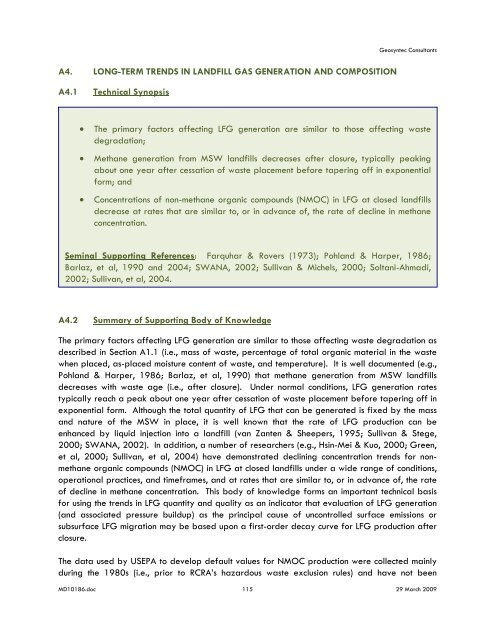AREA A/B ENGINEERING REPORT - Waste Management
AREA A/B ENGINEERING REPORT - Waste Management
AREA A/B ENGINEERING REPORT - Waste Management
You also want an ePaper? Increase the reach of your titles
YUMPU automatically turns print PDFs into web optimized ePapers that Google loves.
A4. LONG-TERM TRENDS IN LANDFILL GAS GENERATION AND COMPOSITION<br />
A4.1 Technical Synopsis<br />
Geosyntec Consultants<br />
• The primary factors affecting LFG generation are similar to those affecting waste<br />
degradation;<br />
• Methane generation from MSW landfills decreases after closure, typically peaking<br />
about one year after cessation of waste placement before tapering off in exponential<br />
form; and<br />
• Concentrations of non-methane organic compounds (NMOC) in LFG at closed landfills<br />
decrease at rates that are similar to, or in advance of, the rate of decline in methane<br />
concentration.<br />
Seminal Supporting References: Farquhar & Rovers (1973); Pohland & Harper, 1986;<br />
Barlaz, et al, 1990 and 2004; SWANA, 2002; Sullivan & Michels, 2000; Soltani-Ahmadi,<br />
2002; Sullivan, et al, 2004.<br />
A4.2 Summary of Supporting Body of Knowledge<br />
The primary factors affecting LFG generation are similar to those affecting waste degradation as<br />
described in Section A1.1 (i.e., mass of waste, percentage of total organic material in the waste<br />
when placed, as-placed moisture content of waste, and temperature). It is well documented (e.g.,<br />
Pohland & Harper, 1986; Barlaz, et al, 1990) that methane generation from MSW landfills<br />
decreases with waste age (i.e., after closure). Under normal conditions, LFG generation rates<br />
typically reach a peak about one year after cessation of waste placement before tapering off in<br />
exponential form. Although the total quantity of LFG that can be generated is fixed by the mass<br />
and nature of the MSW in place, it is well known that the rate of LFG production can be<br />
enhanced by liquid injection into a landfill (van Zanten & Sheepers, 1995; Sullivan & Stege,<br />
2000; SWANA, 2002). In addition, a number of researchers (e.g., Hsin-Mei & Kuo, 2000; Green,<br />
et al, 2000; Sullivan, et al, 2004) have demonstrated declining concentration trends for nonmethane<br />
organic compounds (NMOC) in LFG at closed landfills under a wide range of conditions,<br />
operational practices, and timeframes, and at rates that are similar to, or in advance of, the rate<br />
of decline in methane concentration. This body of knowledge forms an important technical basis<br />
for using the trends in LFG quantity and quality as an indicator that evaluation of LFG generation<br />
(and associated pressure buildup) as the principal cause of uncontrolled surface emissions or<br />
subsurface LFG migration may be based upon a first-order decay curve for LFG production after<br />
closure.<br />
The data used by USEPA to develop default values for NMOC production were collected mainly<br />
during the 1980s (i.e., prior to RCRA’s hazardous waste exclusion rules) and have not been<br />
MD10186.doc 115 29 March 2009

















